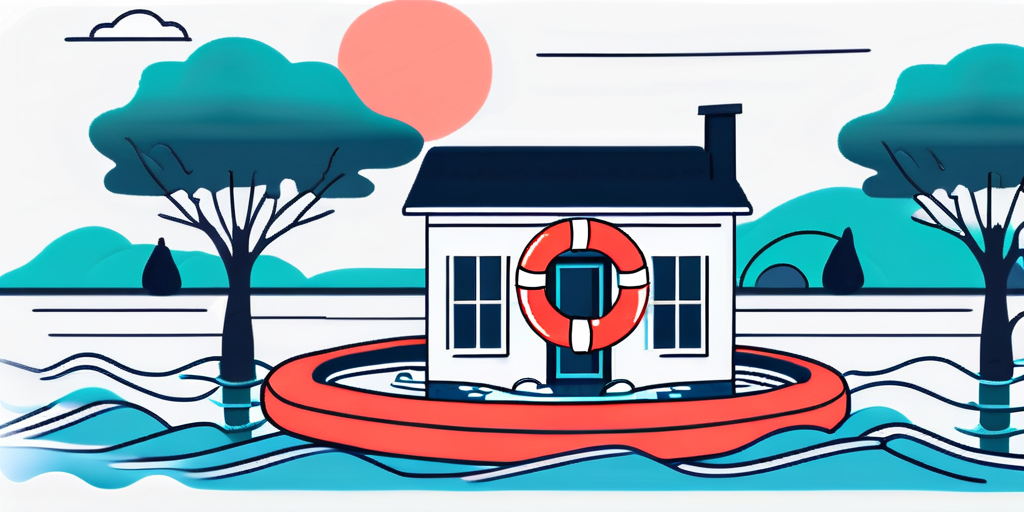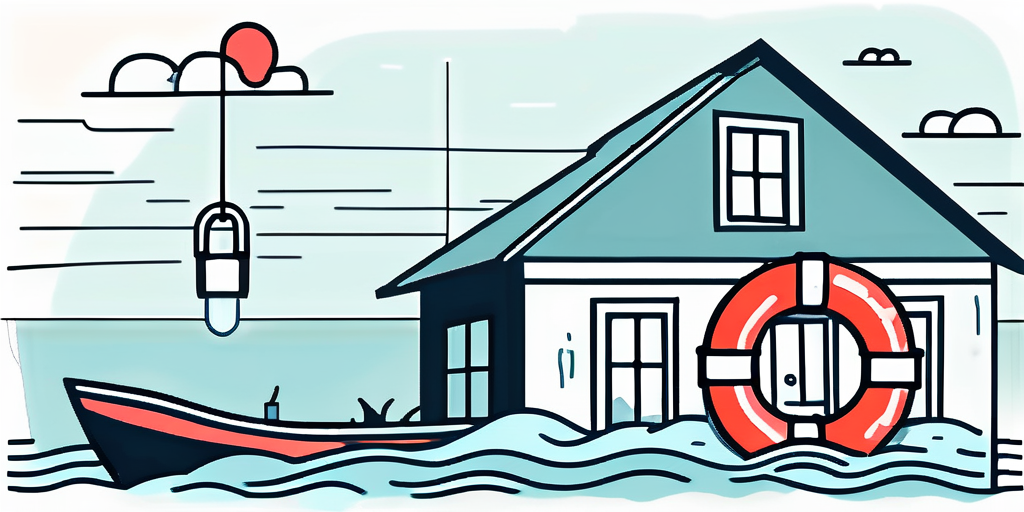Understanding the Basics of Flood Insurance
When it comes to protecting your property from the damages caused by floods, flood insurance plays a vital role. In this section, we will explore the fundamental aspects of flood insurance.

Flood insurance is a specialized type of insurance coverage that provides financial protection for property owners in the event of flood damage. It is important to note that flood insurance is typically not included in standard homeowners insurance policies, so it is essential for property owners in flood-prone areas to secure this additional coverage.
What is Flood Insurance?
Flood insurance is a type of policy that provides coverage for properties that are at risk of flood damage. Unlike typical homeowners insurance, flood insurance is specifically designed to protect against the financial consequences of flooding.
One key aspect of flood insurance is that it covers both the structure of the property and its contents. This means that not only is the physical building protected, but also the personal belongings inside the property. This comprehensive coverage can provide peace of mind for property owners, knowing that they are financially protected in the event of a flood.
Why is Flood Insurance Important?
Flood insurance is crucial because floods can cause significant destruction to homes and belongings. Traditional homeowners insurance policies typically do not cover damages caused by floods, making flood insurance necessary to safeguard your property.
Furthermore, it is important to understand that flood insurance is not just for properties located in high-risk flood zones. Flooding can occur due to various reasons such as heavy rainfall, snowmelt, or even clogged drainage systems. Therefore, having flood insurance can be beneficial for all property owners, regardless of their location.
Decoding the Coverage of Flood Insurance
In this section, we will delve into the details of what flood insurance covers and what it does not cover. It is essential to have a clear understanding of the extent of coverage provided by flood insurance.
Understanding the nuances of flood insurance coverage can be crucial for homeowners living in flood-prone areas. While standard homeowners’ insurance policies do not cover flood damage, flood insurance steps in to provide protection against the devastating effects of flooding.
What Does Flood Insurance Cover?
Flood insurance typically covers damages caused by rising water from natural sources, such as rivers, lakes, or oceans. It includes coverage for structural damage to the building as well as damage to personal possessions within the property, like furniture and appliances.
Moreover, flood insurance can also extend to cover detached garages or outbuildings on the property, offering a comprehensive safety net for homeowners.
Additionally, flood insurance also provides coverage for necessary repairs to electrical and plumbing systems that are damaged due to flooding. This coverage ensures that homeowners can address critical infrastructure issues promptly, minimizing the long-term impact of flood damage.
What is Not Covered by Flood Insurance?
While flood insurance provides essential coverage, it is essential to note that certain items and types of damage may not be covered. For instance, damage caused by mold or mildew resulting from delayed repairs following a flood may not be covered by flood insurance.
Furthermore, flood insurance does not typically cover the loss of additional living expenses incurred while the property is being repaired or restored after a flood. It is important for homeowners to be aware of these limitations and consider additional coverage options to safeguard against unforeseen expenses.
The Cost Factor in Flood Insurance
Understanding the cost of flood insurance is crucial for homeowners and property owners considering purchasing a policy. In this section, we will explore the factors that influence the cost of flood insurance.

Flood insurance is a critical consideration for property owners, as the financial implications of flood damage can be devastating. It is essential to understand the various components that contribute to the cost of flood insurance to make informed decisions about coverage.
How Much Does Flood Insurance Cost?
The cost of flood insurance can vary depending on various factors. These factors include the location of the property, the elevation of the property, the proximity to flood-prone areas, and the coverage limits chosen. In general, higher-risk areas or properties located in flood plains may have higher premiums.
Insurance rates are determined based on the level of risk associated with a property’s location. Properties situated in flood zones designated by the Federal Emergency Management Agency (FEMA) are more likely to experience flooding and, therefore, may have higher insurance premiums.
Factors Influencing the Cost of Flood Insurance
In addition to the property’s location, several other factors can impact the cost of flood insurance. These factors include the construction of the building, the age of the property, the deductible amount selected, and the coverage options chosen by the policyholder.
The age and construction of a property can influence its susceptibility to flood damage. Older buildings or those constructed with materials prone to water damage may result in higher insurance costs due to increased risk. Additionally, selecting a higher deductible can lower premium costs but may require property owners to pay more out of pocket in the event of a flood.
The Process of Purchasing Flood Insurance
In this section, we will guide you through the process of purchasing flood insurance, ensuring that you are adequately protected against flood-related damages.
When considering purchasing flood insurance, it’s essential to understand the different types of coverage available. Standard flood insurance typically covers the structure of your home and its foundation, electrical and plumbing systems, HVAC equipment, appliances, carpeting, and personal belongings. Additional coverage may be necessary for items such as valuable artwork, jewelry, or other high-value possessions.
Where Can You Buy Flood Insurance From?
Flood insurance can be purchased from either private insurance companies or through the National Flood Insurance Program (NFIP), which is offered by the Federal Emergency Management Agency (FEMA). The NFIP provides flood insurance coverage to homeowners, renters, and businesses in participating communities.
Private insurance companies may offer flood insurance policies that provide more extensive coverage options or additional benefits not available through the NFIP. It’s essential to research and compare policies from different providers to find the best fit for your specific needs and budget.
How to Choose the Right Flood Insurance?
Choosing the right flood insurance policy is crucial to ensure that you have adequate coverage. Before selecting a policy, consider factors such as the property’s flood risk, the value of the property and its contents, and your budget. It is advisable to compare policies and coverage options from different insurers before making a decision.
Additionally, when evaluating flood insurance options, be sure to review the policy’s coverage limits, deductibles, and any exclusions that may apply. Understanding the terms and conditions of your flood insurance policy can help you make an informed decision and avoid any surprises in the event of a flood-related claim.
Claiming Flood Insurance
In this section, we will explore the process of filing a claim for flood insurance and understanding how the claim settlement process works.

When it comes to filing a claim for flood insurance, timing is crucial. As soon as you notice flood damage to your property, it is essential to promptly reach out to your flood insurance provider. The sooner you start the claims process, the sooner you can begin the journey towards recovering from the damages. Remember, providing your insurance company with all the necessary documentation and evidence of the damages incurred will help expedite the process.
How to File a Claim for Flood Insurance?
If your property has suffered flood damage, it is essential to promptly file a claim with your flood insurance provider. Contact your insurance company or agent as soon as possible to begin the claims process. Provide them with all the necessary documentation and evidence of the damages incurred.
Additionally, it is advisable to document the damages through photographs or videos to provide a visual representation of the impact of the flood. This visual evidence can further support your claim and ensure that all damages are properly accounted for during the assessment process.
Understanding the Claim Settlement Process
Once the claim is filed, the insurance company will assess the damages and determine the coverage amount based on the policy terms and conditions. The claim settlement process may involve inspections, evaluations, and verification of the damages. It is important to communicate and cooperate with the insurance company throughout the process to facilitate a smooth and fair settlement.
Moreover, it is crucial to review your insurance policy carefully to understand the extent of your coverage and any limitations that may apply. Being aware of what is included in your policy can help manage expectations during the claim settlement process and avoid any surprises regarding coverage.
In conclusion, understanding the basics of flood insurance, decoding its coverage, considering the cost factors, knowing the process of purchasing flood insurance, and being aware of the claiming process are essential to protect your property and navigate the complexities of flood insurance. By being well-informed, you can make informed decisions and secure your property against the risks of flooding.
